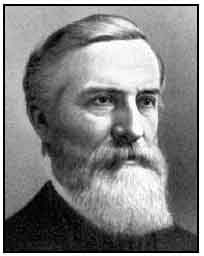Recently, an 11 acre expanse of vacant land was created in Little Village. The Liquid Carbonic factory turned Washburne Trade School has been demolished, following more than a decade of vacancy. Prior to demolition, there was political turmoil regarding the use of the Washburne site. Local activists and politicians wanted to tear the structure down and build a park in its place. Proponents of this plan have stated that Little Village lacks adequate park space, and the site is a good opportunity, considering that the land is already publicly owned. Some local residents saw the structure as a dangerous eyesore, others, namely the Landmarks Preservation Council of Illinois, believed it could have been adaptively reused. Washburne was originally slated for demolition in 2005 until the city ordered a stay of demolition. A study was then conducted to determine if the building was going to be granted landmark status. It wasn’t.


Left: Chicago Daily News negatives collection, DN-0004107. Right: Brady-Handy Photograph Collection, Library of Congress, LC-DIG-cwpbh-00599.
Right: Elihu Benjamin Washburne
In 1887, Elihu Benjamin Washburne, a former Illinois congressman from Galena, died. Subsequently, West 14th Street elementary school was renamed in his honor. Located on 14th street near Union, the school continued as an elementary school until 1919, when it was re-named and re-purposed. With the sponsorship of numerous Unions, Washburne Trade and Continuance school began training high school age students for various vocational careers. Beginning with carpentry and electrical engineering, the school rapidly expanded its programs throughout the 1920’s.
Drugstore owner Jacob Baur, pictured at left, moved to Chicago from Terre Haute, Indiana in 1888. He set up a business producing carbonic gas for soft drinks on Illinois street in the present-day River North area. The business quickly increased production to the point where Baur was selling his own soda fountains and all the accoutrements, achieving fame as the inventor of the soda fountain. The company’s major product, however, remained liquid carbonic, which is a pressurized, liquefied gas consisting mostly of carbon dioxide. We know it primarily as the carbonation in soft drinks, but it is also useful in a variety of applications from fire extinguishers to air coolant.
Baur’s company re-located from the Illinois street location in 1910 to a new prairie school style factory on 31st and Kedzie designed by the architectural firm of Nimmons and Fellows. One of the firm’s most famous buildings is the original Sears Tower — the Sears Merchandise Building Tower located at the corner of Arthington and Homan.
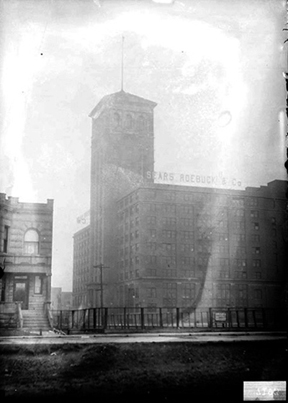

Left: Chicago Daily News negatives collection, DN-0007193. Right: Chicago Daily News negatives collection, DN-0080527.
Right: Bertha Baur, 1926.
|
Jacob Baur died in 1912, leaving his 55% of the company to his wife, Bertha. She remained with the company as vice-president until 1926 when she sold her interest for $3 million. After leaving the company, she entered politics, serving as a delegate to the Republican National Convention in 1932. She ran for, but did not win a seat in the Illinois House of Representatives in 1936. However, she remained a Republican committee member until 1943, and outlived her husband by half a century, dying in 1967.
Washburne Trade and Continuance school outgrew its former elementary school environs and changed locations in 1934, moving north to Division and Sedgwick. It wouldn’t be long until the school moved yet again, this time south to the vacated Liquid Carbonic plant on 31st and Kedzie. The plant received an addition in 1935, a now-demolished Art Moderne style administration building designed by S.D. Gratias, which fronted onto Kedzie avenue. Chicago Public Schools purchased the plant in 1958 for $1.8 million. By the time of the move, Washburne handled all of the vocational apprenticeships within the Chicago Public Schools. However, problems began to arise. Prior to the mid to late 1960s, the school was primarily white. When the school began to be desegregated, unions began to pull programs. There were 17 different unions at the school in 1965. A mere 13 years later, the number of unions had been cut nearly in half, with 8 remaining. By the time of the school’s first closure in 1993, only 2 programs remained. |
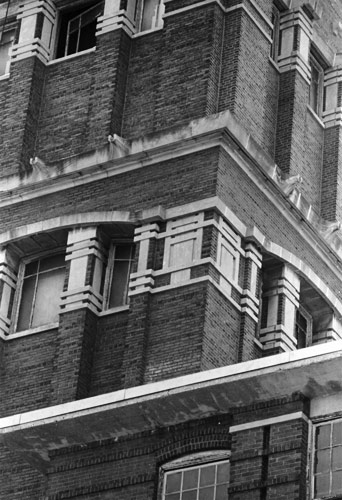
Prairie school style detailing characteristic of Nimmons on Washburne’s tower.
|
In 1994, Washburne re-opened under the City College system, but did not remain in the building much longer. Closing again in 1996, the culinary program moved to Kennedy-King College, renamed the Washburne Culinary Institute. The culinary program, which moved again to the South Shore Cultural Center in the mid-2000s, had long been the school’s best program, and one of the best in the country, a reputation it still carries.
The Liquid Carbonic/Washburne Trade School buildings have been vacant since 1996. We first visited the factory in 2002 and have returned a number of times since. The four following photographs are from 2002/03, prior to any demolition work.
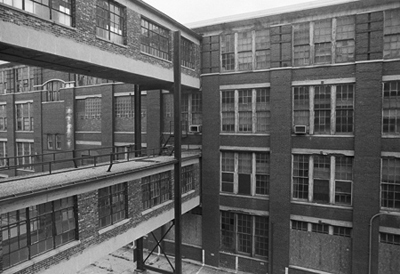
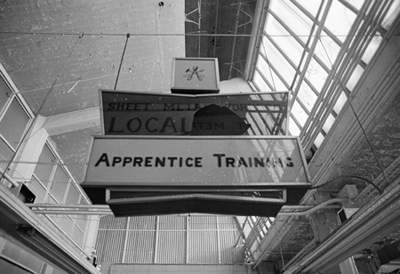
Left: View west of the pedestrian bridge connecting the main building to the 1935 addition. This picture was taken from the addition.
Right: This is a sign indicating the area used for training sheet metal workers, probably made by said students.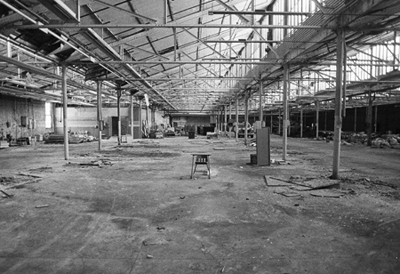
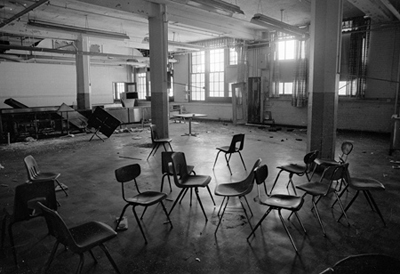
Left: The now-demolished garage.
Right: The cafeteria. At this point, the interior was in a relatively pristine state, as far as abandoned buildings go.
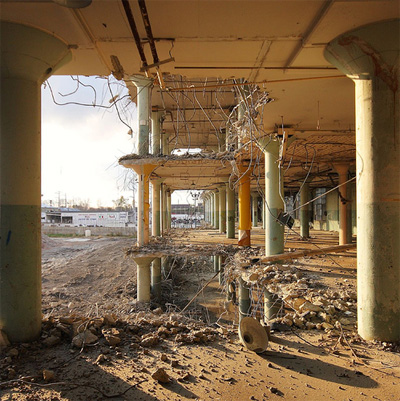 Noah Vaughn, 2007 |
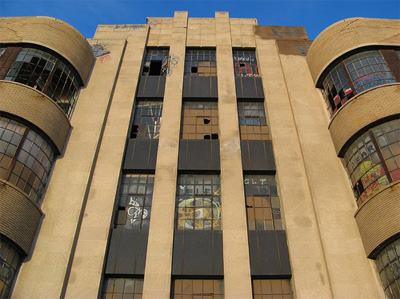 Noah Vaughn is an excellent photographer who has documented numerous abandoned buildings in the Chicagoland area, including Washburne. We’ve included two of his images, above and left. He has many, many more images chronicling the demolition of Washburne, which you can find at his Flickr page and his blog, Dump Site. |
Left: This is the second floor of the main building, facing west. The garage/warehouse seen in the image above this one was located on the left hand side of this image. Demolition encroaches…
Right: The Administration building overrun with graffiti.The following images were provided by an anonymous urban explorer, and were taken circa 2003.




Left: Reminiscent of a Byzantine church, this miniature cross-section has been left to the taggers. Tiny street toughs must have smashed out the miniature replica stained ‘glass’ windows.
Right: Obsolete, vandalized computer equipment.We found this pamphlet in Washburne. We don’t know the exact date, but based on the names at the bottom, and the graphic design style, the late 1950s or early 1960s is our best educated guess.


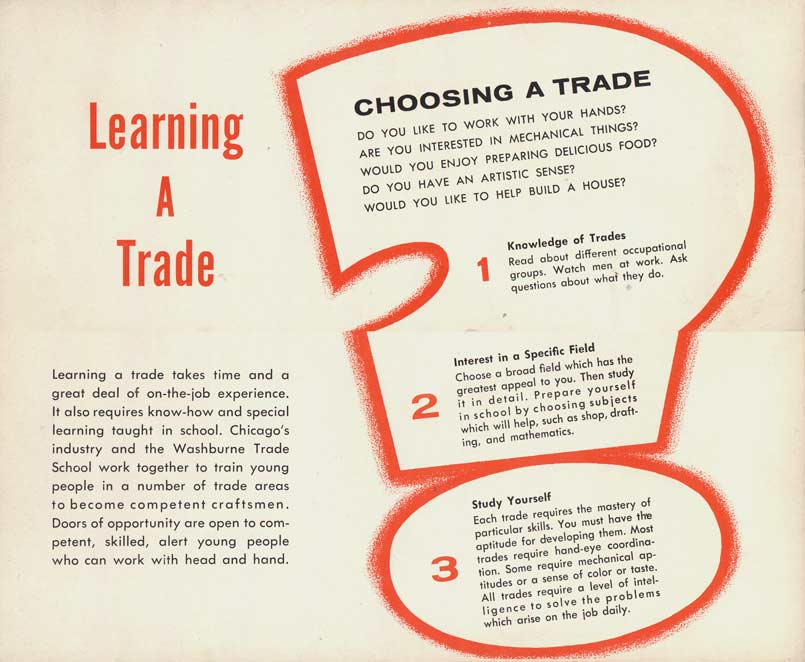

Dry Ice. Time Magazine, 28 Feb. 1927. http://www.time.com/time/magazine/article/0,9171,730099,00.html
Soda Water Split. Time Magazine, 28 Jun. 1937.http://www.time.com/time/magazine/article/0,9171,788115,00.html
Washburne Trade School. Landmarks Preservation Council of Illinois, 2006 (Accessed 18 Jan. 2007).
http://www.landmarks.org/chicago_watch_2006_11.htm
Little Village leaders meet with schools president. New Communities Program, 15 Dec 2006 (Accessed 18 Jan. 2007).http://www.newcommunities.org/communities/littlevillage/articleDetail.asp?objectID=678&communityID=6
Fink, Leon et al. The Labor Trail: Chicago’s History of Working-Class Life and Struggle. University of Illinois at Chicago, 2006. (Accessed 18 Jan. 2007).http://www.communitywalk.com/map/5258#0003On3
Gordon, Danielle. Washburne Update: Restraint of Trades. The Chicago Reporter, September/October 1994.
http://www.chicagoreporter.com/1994/09-94/0994WashburneUpdateRestraintofTrades.htm
Hayner, Don and Tom McNamee. Streetwise Chicago: A History of Chicago Street Names.
Chicago: Loyola University Press, 1988.
Kestenbaum, Lawrence. The Political Graveyard – Battles to Baxmeyer. last updated 10 Mar. 2005 (accessed 18 Jan. 2007). http://politicalgraveyard.com/bio/battles-baxmeyer.html
Lynch, La Risa. Washburne’s Checkered Past. The Chicago Reporter, September/October 1994. http://www.chicagoreporter.com/1994/09-94/0994SidebarWashburne’sCheckeredPast.htm
Marin, Carol. Battle For Little Village Park Grows To Titanic Proportions. NBC5, Chicago. 21 Oct. 2005.http://www.nbc5.com/news/5132582/detail.html
Zilversmit, Arthur. Schooling for Work. Encyclopedia of Chicago, 2005. (Accessed 18 Jan. 2007).http://www.encyclopedia.chicagohistory.org/pages/1123.html
- Fire Insurance Patrol Stations
- Disused Police Stations
- Maps
- The Little House on Polk Street
- Media & Press

